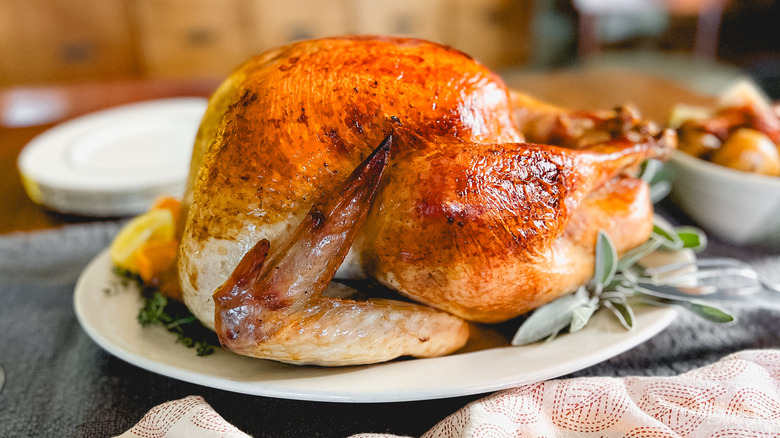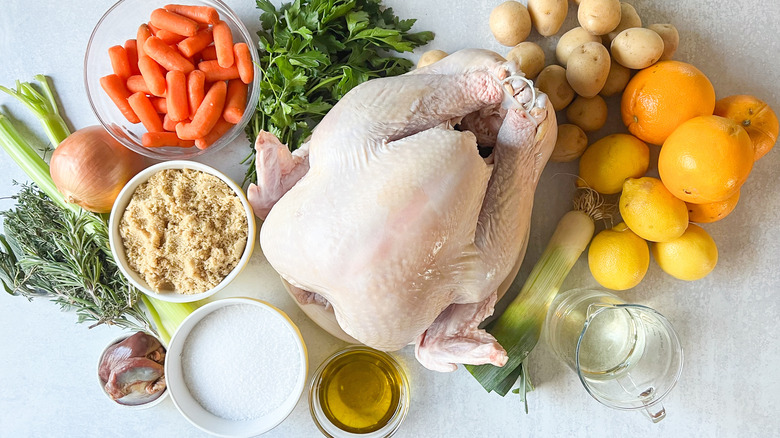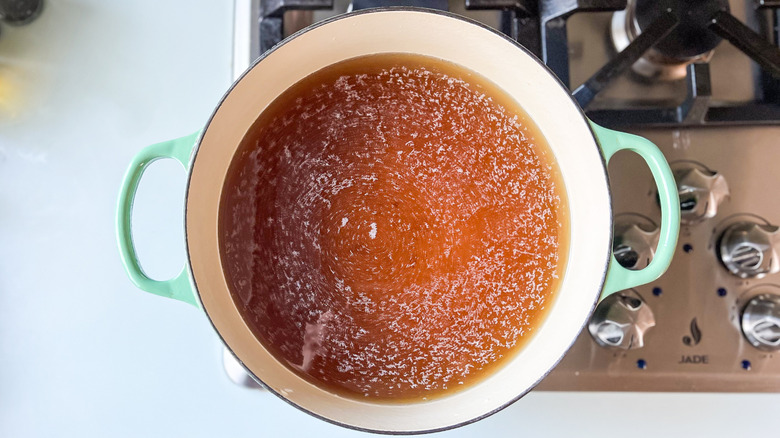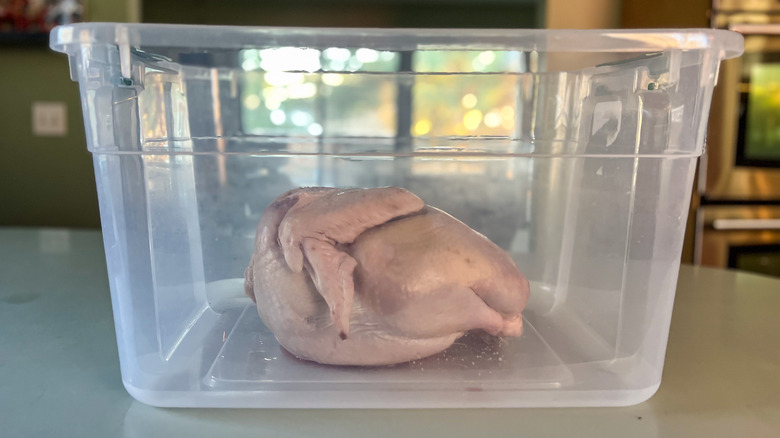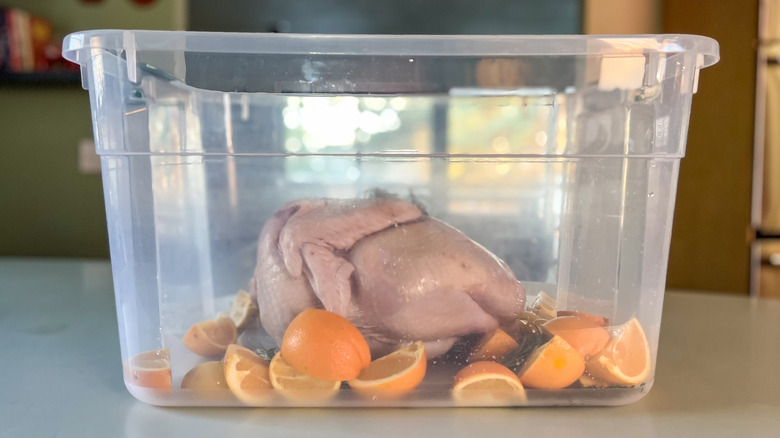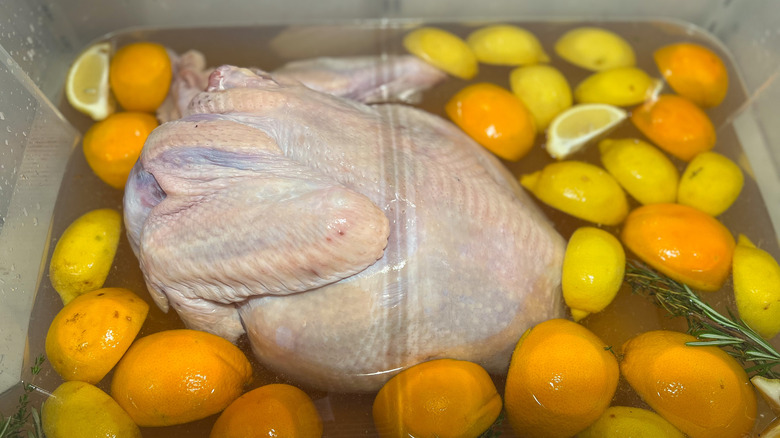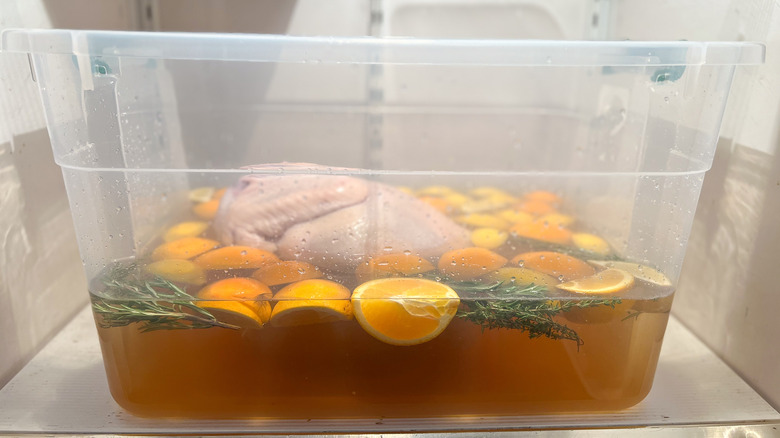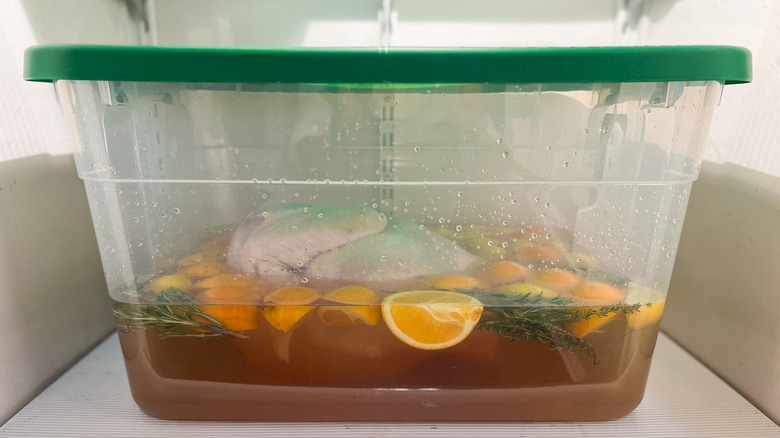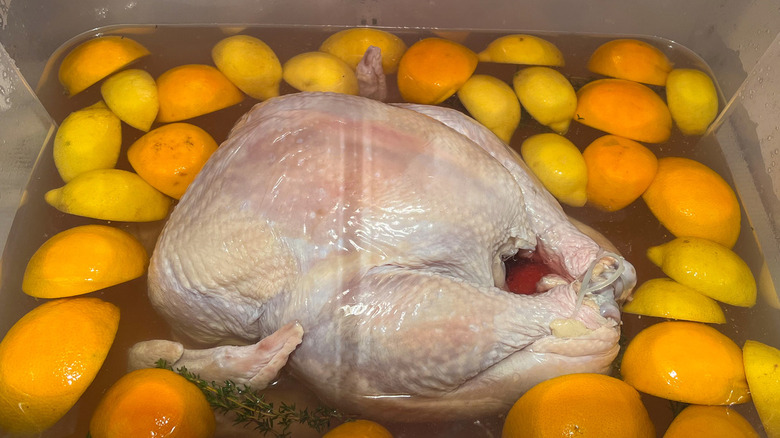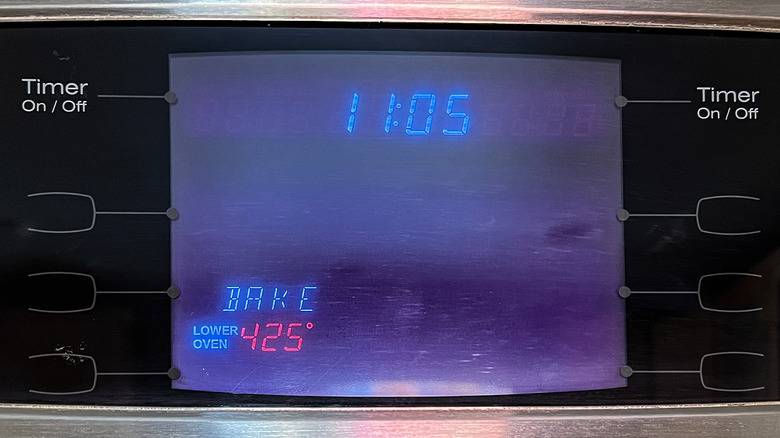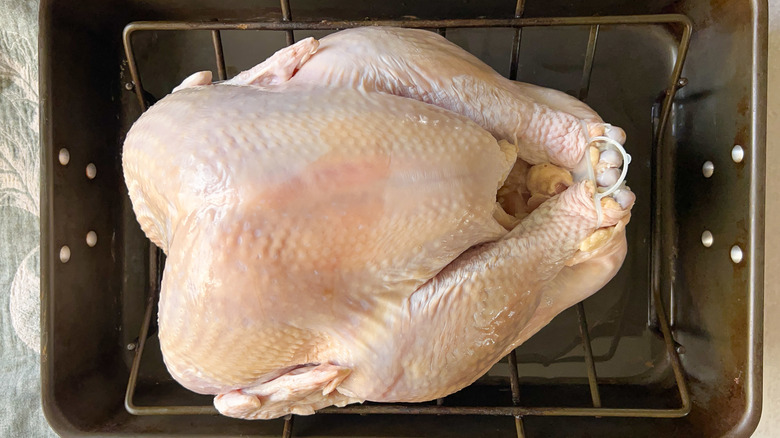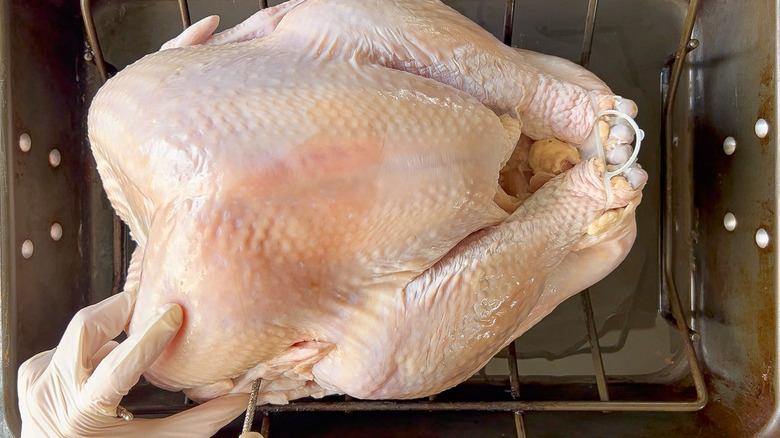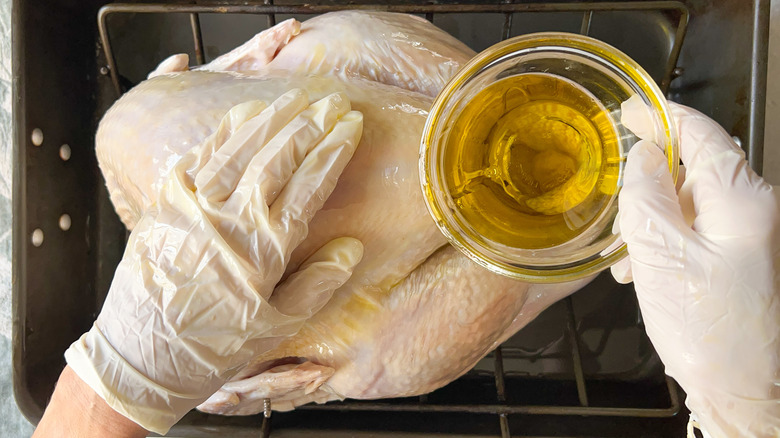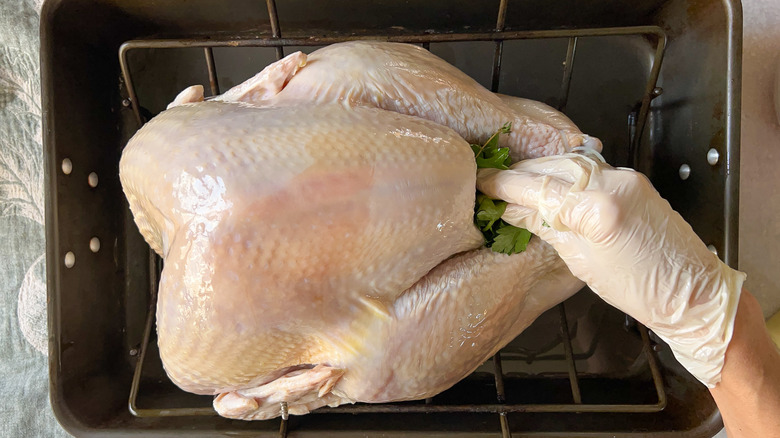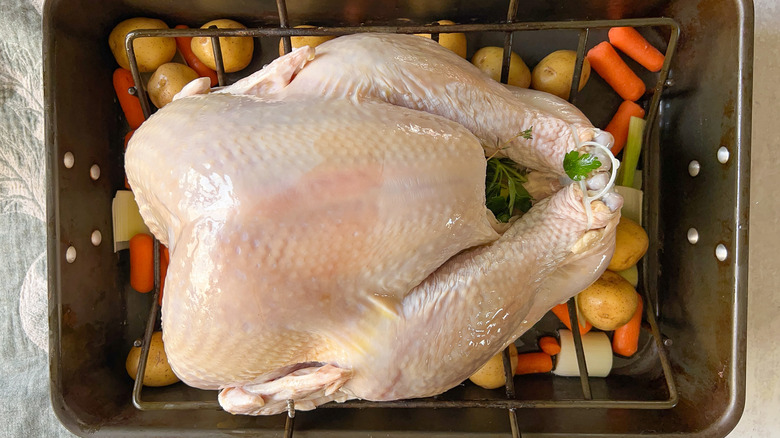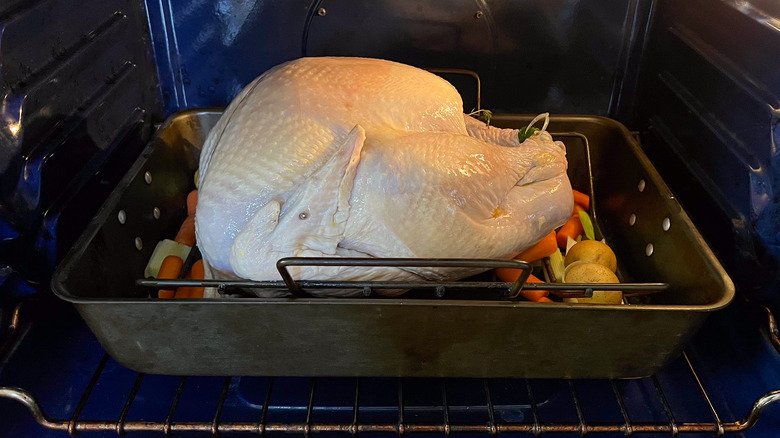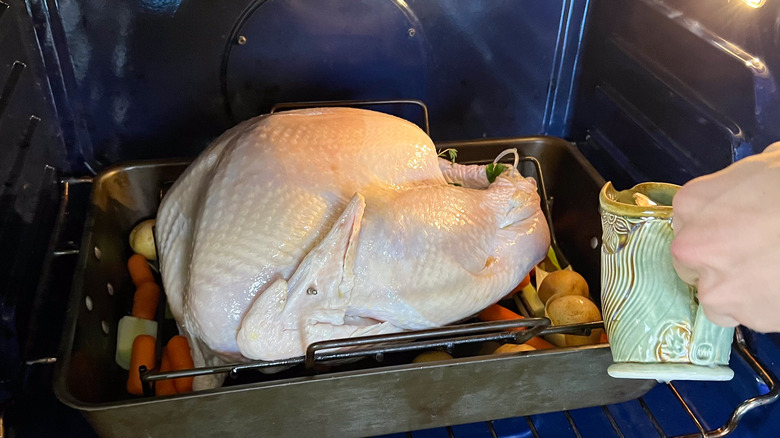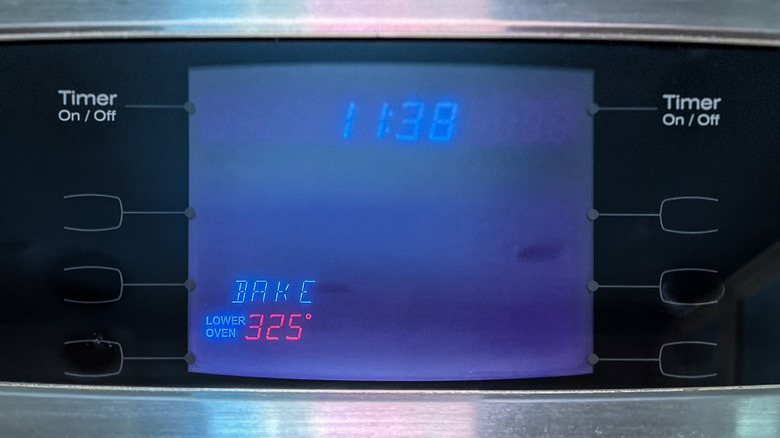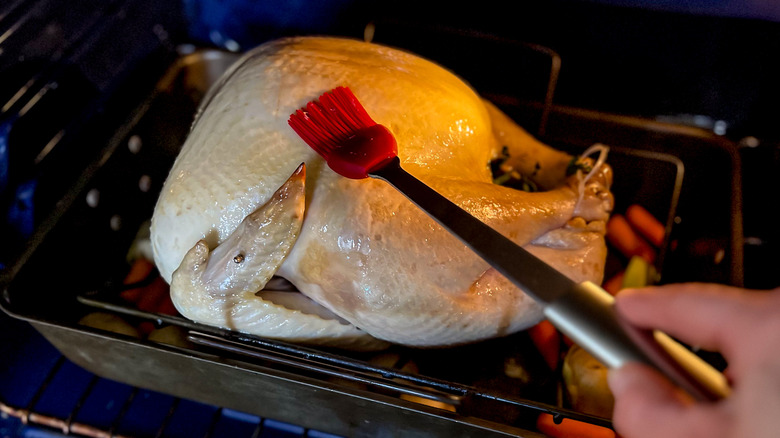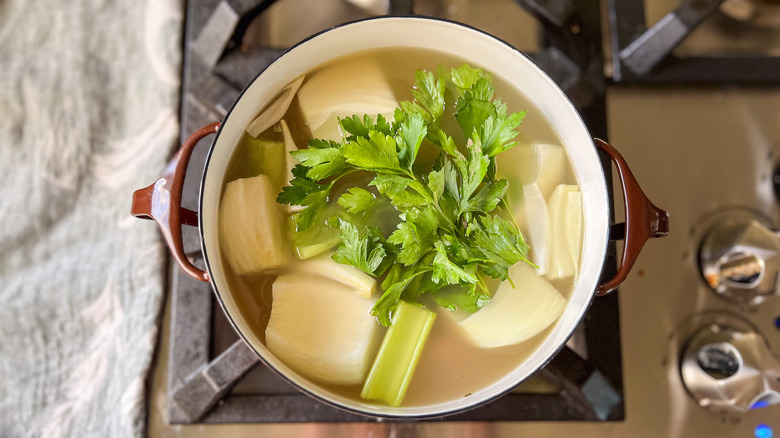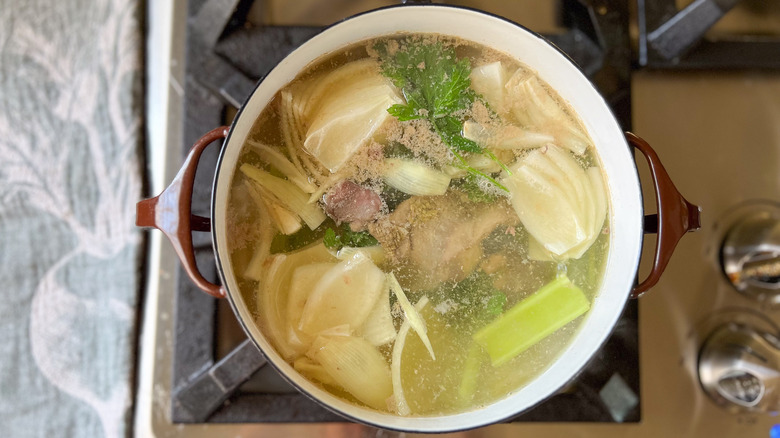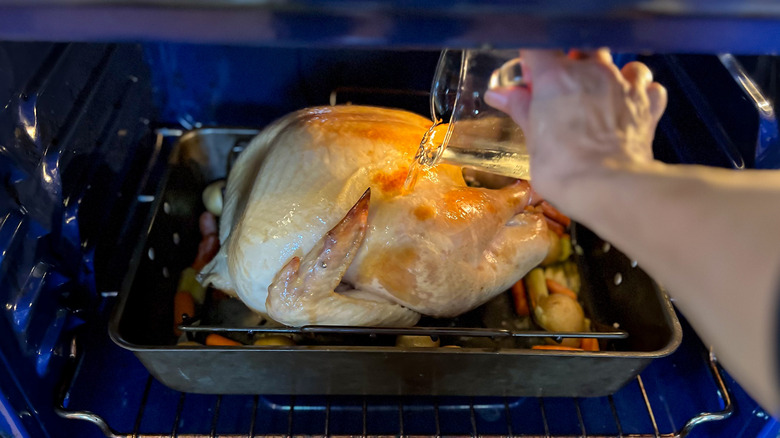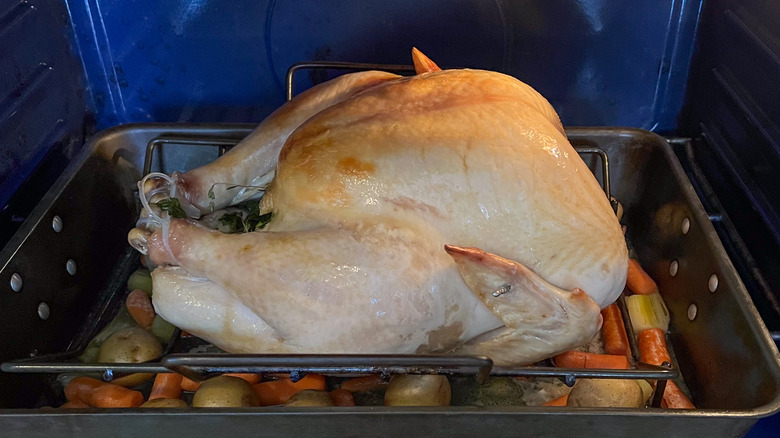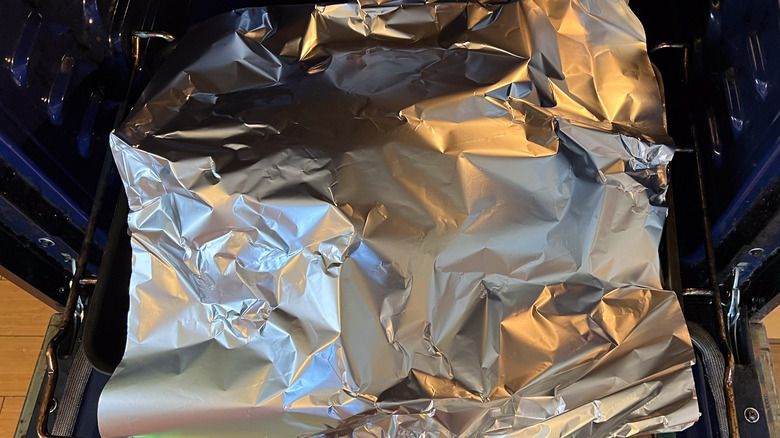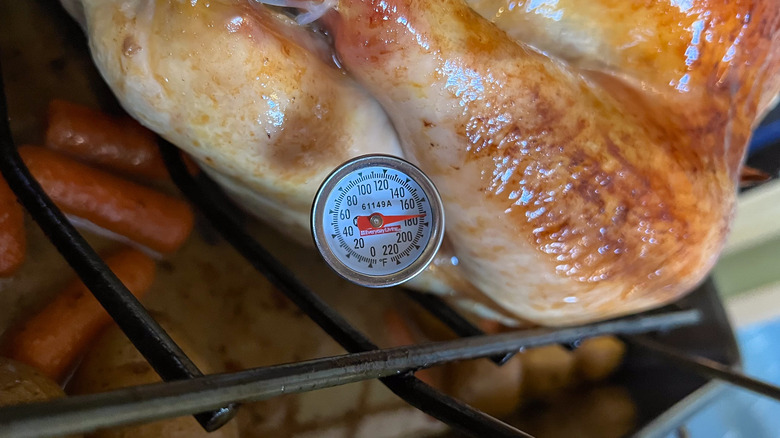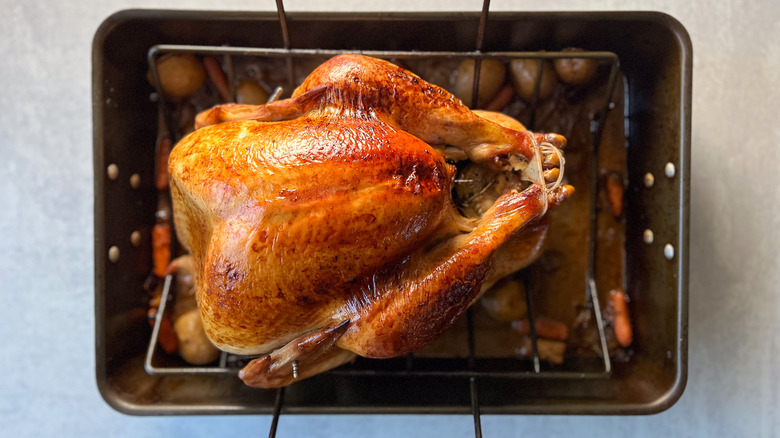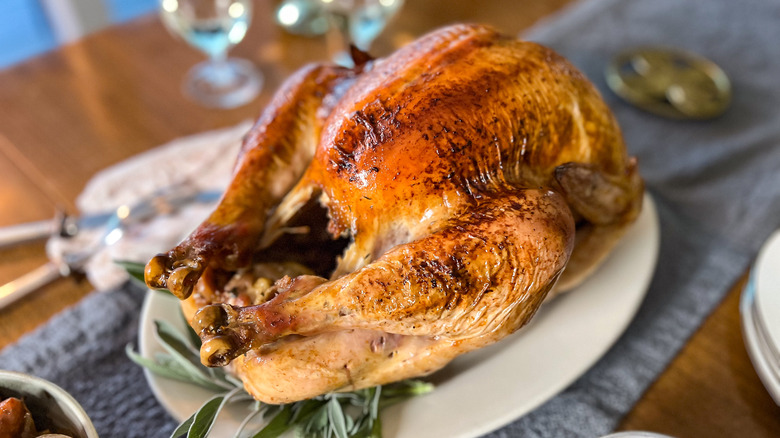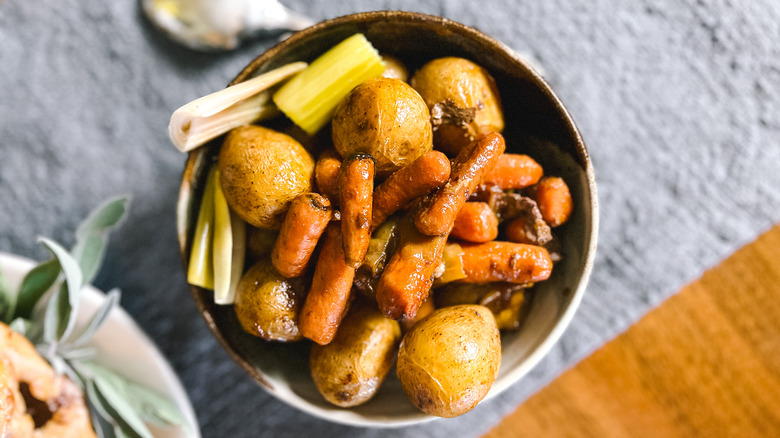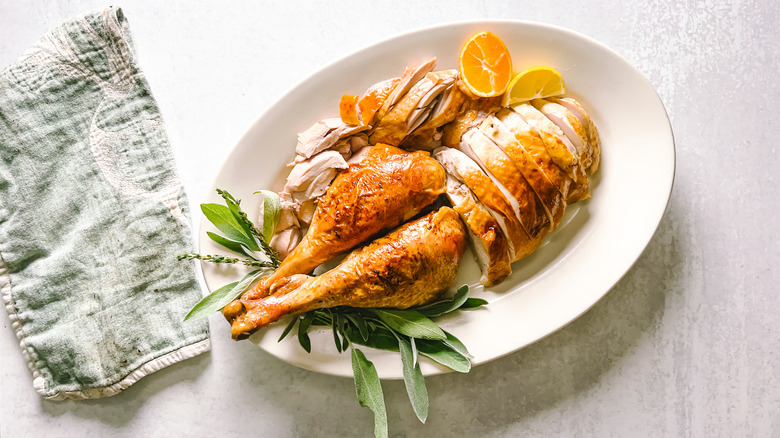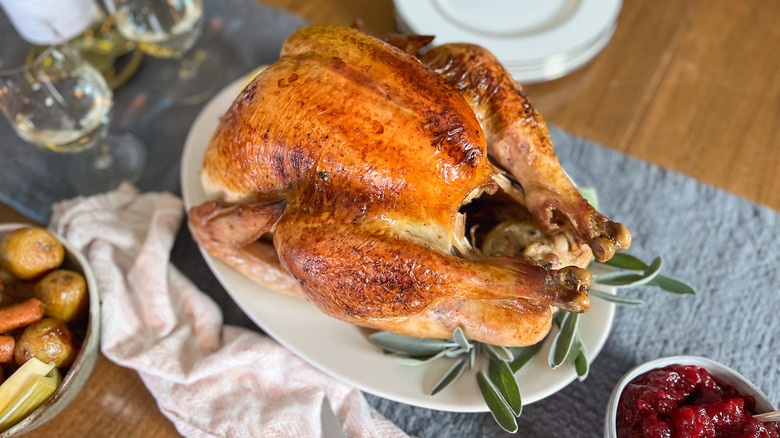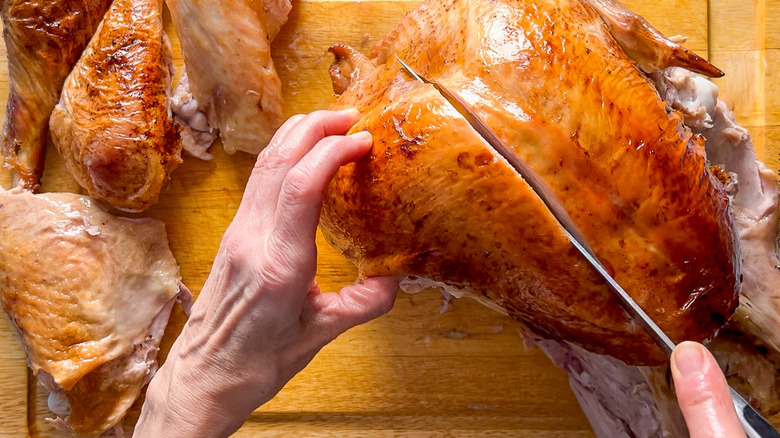Basic Roasted Turkey Recipe
Preparing a whole roasted turkey is often reserved just for the holidays, but there is no reason why you can't enjoy fresh from the oven juicy turkey at any time of the year. Learning some foolproof tricks for achieving a beautiful bird will give you the confidence to wow your family and friends and have plenty of leftovers during any season. This recipe for basic roasted turkey — courtesy of recipe developer Julie Kinnaird – will teach you how to brine and roast a perfect turkey for any occasion.
Brining in a solution of kosher salt and brown sugar yields a juicy roasted turkey that tends to cook more quickly and evenly than a non-brined bird. The addition of citrus fruits and fresh herbs to the brine seasons the meat ahead of roasting. Kinnaird prefers to leave the bird un-stuffed, adding only a few aromatic vegetables and herbs to the turkey cavity as well as the pan. The result is a flavorful, golden brown bird with delicious pan vegetables that take on all of the wonderful juices.
Gather the basic roasted turkey ingredients
To prepare the basic roasted turkey, you will want to start with a high-quality bird. This recipe is based on a 14-pound turkey, however, the ingredient amounts will work for birds within the 12 to 16-pound range. To create the turkey brine, you will need kosher salt, brown sugar, oranges, lemons, fresh thyme and rosemary, and 4 gallons of cold water. Once the turkey has brined and is ready to roast, you will want to have ready some olive oil, celery, baby carrots, a large leek, fresh Italian parsley and sage, some petite potatoes, a yellow onion, and a bit of dry white wine. Some of these ingredients will be used for roasting the turkey, as well as creating a quick stock from the neck and giblets to be used for basting.
Step 1: Prepare the brine
Combine the kosher salt and brown sugar in a large heavy pot with 1 gallon of cold water. Heat slightly and stir to dissolve. Remove the pot from heat and cool completely.
Step 2: Place turkey in brining container
Place the turkey breast side down into a large plastic or other container that will fit the turkey and 4 total gallons of water.
Step 3: Add citrus and herbs
Add the oranges, lemons, 6 sprigs thyme, and 6 sprigs rosemary to the container.
Step 4: Add brining liquid and refrigerate
Pour in the salt and brown sugar mixture and place the container in a refrigerator.
Step 5: Add remaining water
Add the remaining 3 gallons of cold water.
Step 6: Cover and refrigerate
Cover and let the turkey brine for at least 8 hours, preferably 24.
Step 7: Turn the turkey breast-side-up
Turn the turkey breast side up halfway into the brine process.
Step 8: Preheat
Preheat the oven to 425 F.
Step 9: Place turkey in roasting pan
Prepare a roasting pan with a rack that sits at least 1 inch off the bottom of the pan, and place the turkey from the brine breast side up onto the rack.
Step 10: Pin down wings
Tuck or pin down the wings of the bird with skewers, if desired.
Step 11: Rub turkey with olive oil
Rub the entire surface of the turkey with olive oil.
Step 12: Fill turkey with aromatics
Place half of the celery, ½ cup baby carrots, half of the leeks, half of the parsley, the sage, and remaining thyme and rosemary into the cavity of the bird.
Step 13: Arrange vegetables in pan
Arrange the remaining carrots, potatoes, and leeks around the turkey at the bottom of the pan.
Step 14: Place turkey in oven
Place the pan on the bottom rack of the oven.
Step 15: Add water to roasting pan
Add 2 cups of water to the pan and roast the turkey for 20 minutes.
Step 16: Turn down the heat
Turn the oven temperature down to 325 F.
Step 17: Baste the turkey
Use a brush to baste the bird with the pan juices and continue basting every 20 minutes.
Step 18: Start the turkey stock
While the turkey roasts, place the reserved neck and gizzards, onion, and remaining celery and parsley into a saucepan and cover with water.
Step 19: Simmer the stock
Simmer the stock during the roasting process and use this liquid to add to the pan for basting.
Step 20: Add wine to pan
2 hours into roasting, pour the wine over the bird.
Step 21: Rotate the pan during roasting
Rotate the pan at least once for even browning while roasting.
Step 22: Tent pan loosely with foil
Once the skin is nicely browned, tent the pan loosely with foil. Continue to baste every 20 minutes.
Step 23: Check internal temperature
Start checking the temperature in the thickest part of the thigh with a meat thermometer at around 3 hours of cooking time. A 14-pound bird will take about 3 1/2 hours to reach 170 F.
Step 24: Remove turkey from oven
Remove the turkey from the oven and let rest for at least 20 minutes before carving.
Step 25: Place turkey on serving platter
Remove the vegetables and herbs from the cavity and place the turkey on a serving platter.
Step 26: Serve turkey with pan vegetables
Serve the roasted pan vegetables and any favorite trimmings with the turkey.
Why should I use a brine for a roasted turkey?
Brining your basic roasted turkey first adds an extra step in the process, but also has so many benefits, according to Kinnaird. Turkey is a relatively lean meat. Brining allows for extra moisture to be absorbed, which keeps the bird juicy and prevents drying. The kosher salt not only seasons the meat but also purifies the tissues and helps to break down protein. Brown sugar adds flavor and promotes nice even browning while roasting. Oranges, lemons, and fresh herbs add a bright flavor to the brine that enhances the turkey without taking away from its natural flavor.
Be sure to brine your turkey in a container such as a stainless steel or enameled stockpot, or a food-grade plastic bucket like the one used in this recipe, so that the acid in the citrus will not react. Brining also has the benefit of helping to thaw a partially frozen bird and allows the turkey to cook more quickly and evenly.
What are some tips and tricks for a perfect roasted turkey?
Kinnaird says the key to success when preparing a basic roasted turkey is a bit of advanced planning. Thaw a frozen turkey in the fridge for several days. If you still find that your bird is a bit frozen when you are ready to brine, remember that brining will finish the thawing process.
Don't discard the neck and gizzards from the bird. These make a useful stock for basting or for making gravy after roasting. Try to get a bit of oil up under the skin of the breast for extra tenderness, or switch in a bit of melted butter. Filling your turkey with aromatic vegetables and herbs rather than dressing (i.e. stuffing) helps the turkey to roast more evenly from the outside in. Bake your dressing separately from the bird, and then drizzle with some of the pan juices before serving to give that baked-in flavor.
Oven temperature is also important. Starting with a hot oven helps to sear the skin and seal in moisture, followed by roasting at a lower temperature for slow cooking. Tenting the pan with foil once the skin is nicely browned will prevent dark spots or burning. When checking the temperature, use an instant-read thermometer inserted into the thickest part of the thigh. Promptly remove the turkey from the oven once it reaches 170 F. Give the turkey plenty of time to rest before carving.
What is the best way to carve and serve roasted turkey?
When carving your basic roasted turkey, allow it to rest for 20-30 minutes after coming out of the oven so that the juices can redistribute throughout the meat. Place the turkey on a sturdy large cutting board, have a kitchen towel handy for cleaning up juices, and use a sharp carving knife that can easily slice through the meat and any connective tissue. Start by removing the legs: Use your hand to bend back a drumstick to expose the joint with the thigh. Cut through the joint to remove the drum.
Next, separate the thigh from the body by gently bending back the thigh and cutting through the connecting joint. Remove the wings from the joint to serve separately. For the breast, locate the center of the breastbone and cut down along the edge following the curve of the bone to remove one side of the meat. Cut the breast and thigh into slices for serving. Repeat this process for the other side of the turkey. Use the carcass to make turkey stock by breaking it apart into smaller sections that will fit into a pot.
Basic Roasted Turkey Recipe
This recipe yields a flavorful, golden brown turkey with delicious pan vegetables that take on all of the wonderful juices.
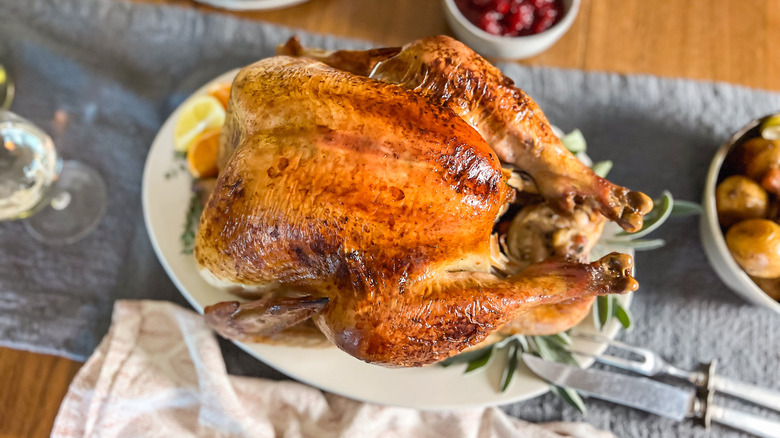
Ingredients
- 1 cup kosher salt
- 1 cup light brown sugar
- 1 (14-pound) turkey, neck and giblets removed from cavity and reserved
- 4 oranges, quartered
- 4 lemons, quartered
- 8 sprigs fresh thyme, divided
- 8 sprigs fresh rosemary, divided
- 1/3 cup olive oil
- 2 stalks celery, cut into 3-inch lengths, divided
- 2 cups baby carrots, divided
- 1 large leek, stem end and green stalks removed, sliced into quarters, divided
- 1 small bunch Italian parsley, divided
- 1 large bunch fresh sage
- 1 pound petite potatoes
- 1 large yellow onion, peeled and cut into quarters
- 1 cup dry white wine
Directions
- Combine the kosher salt and brown sugar in a large heavy pot with 1 gallon of cold water. Heat slightly and stir to dissolve. Remove the pot from heat and cool completely.
- Place the turkey breast side down into a large plastic or other container that will fit the turkey and 4 total gallons of water.
- Add the oranges, lemons, 6 sprigs thyme, and 6 sprigs rosemary to the container.
- Pour in the salt and brown sugar mixture and place the container in a refrigerator.
- Add the remaining 3 gallons of cold water.
- Cover and let the turkey brine for at least 8 hours, preferably 24.
- Turn the turkey breast side up halfway into the brine process.
- Preheat the oven to 425 F.
- Prepare a roasting pan with a rack that sits at least 1 inch off the bottom of the pan and place the turkey from the brine breast side up onto the rack.
- Tuck or pin down the wings of the bird with skewers, if desired.
- Rub the entire surface of the turkey with olive oil.
- Place half of the celery, ½ cup baby carrots, half of the leeks, half of the parsley, the sage, and remaining thyme and rosemary into the cavity of the bird.
- Arrange the remaining carrots, potatoes, and leeks around the turkey at the bottom of the pan.
- Place the pan on the bottom rack of the oven.
- Add 2 cups of water to the pan and roast the turkey for 20 minutes.
- Turn the oven temperature down to 325 F.
- Use a brush to baste the bird with the pan juices and continue basting every 20 minutes.
- While the turkey roasts, place the reserved neck and gizzards, onion, and remaining celery and parsley into a saucepan and cover with water.
- Simmer the stock during the roasting process and use this liquid to add to the pan for basting.
- 2 hours into roasting, pour the wine over the bird.
- Rotate the pan at least once for even browning while roasting.
- Once the skin is nicely browned, tent the pan loosely with foil. Continue to baste every 20 minutes.
- Start checking the temperature in the thickest part of the thigh with a meat thermometer at around 3 hours of cooking time. A 14-pound bird will take about 3 1/2 hours to reach 170 F.
- Remove the turkey from the oven and let rest for at least 20 minutes before carving.
- Remove the vegetables and herbs from the cavity and place the turkey on a serving platter.
- Serve the roasted pan vegetables and any favorite trimmings with the turkey.
